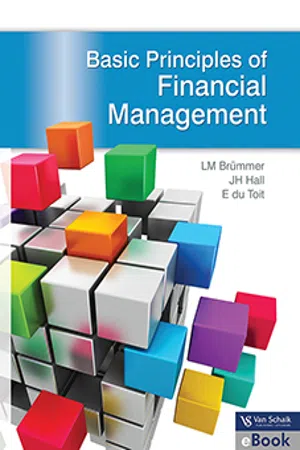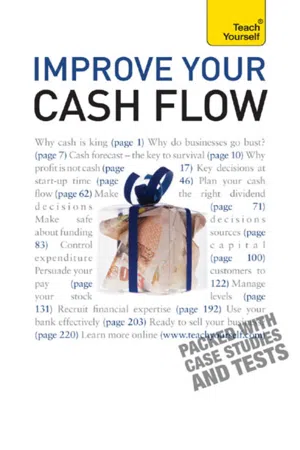Cash Flow Forecast
A cash flow forecast is a financial tool used to predict the future inflows and outflows of cash within a business over a specific period. It helps businesses anticipate their financial position and plan for potential cash shortages or surpluses. By analyzing expected cash flows, businesses can make informed decisions about investments, expenses, and financing.
8 Key excerpts on "Cash Flow Forecast"
- eBook - ePub
- Brümmer LM, Hall JH, Du Toit E(Authors)
- 2017(Publication Date)
- Van Schaik Publishers(Publisher)
...It has been said that cash represents the lifeblood of the organisation. The Cash Flow Forecast, as an integral part of the financial planning process, is an important tool in the hands of the financial manager to forecast and manage the cash flow of an organisation. A thorough understanding and correct application of the cash budget of an organisation is critical for enhancing profitability, managing future cash flow and ensuring the short- and long-term sustainability of the organisation. Conclusion In this chapter we discussed financial planning in terms of budgets, highlighting their conditions and functions. Thereafter the cash budget was introduced and the importance of the lagging effect of cash collections of debtors was illustrated. The role of the proforma Statement of Comprehensive Income and Statement of Financial Position was discussed. Progress reporting and control of budget deviations was deliberated. The chapter concluded by underlining the importance of budgets as a financial management tool. Self-test questions Prepare a cash flow projection for Coldstart (Pty) Ltd for the months December, January and February from the following information, using the format provided. Coldstart (Pty) Ltd had sales of R50 000 in October and R60 000 in November. Expected sales for December, January and February are R70 000, R80 000 and R100 000 respectively. The balance in the bank at the end of November was R5 000. 140 Of the organisation’s sales, 20% are for cash, 60% are collected one month after sales have taken place, and 20% two months after that. The company collects R2 000 every month for a surplus storeroom it sublets. Expected purchases are R50 000, R70 000 and R80 000 for December to February, respectively. This will be paid in cash. Rent for offices is R3 000 per month. Salaries are paid in the form of commission of 10% of sales...
- eBook - ePub
- Robert McCallion, Alan Warner(Authors)
- 2010(Publication Date)
- Teach Yourself(Publisher)
...risk. The length and complexity of these questions shows that this is not a decision to be taken easily or lightly. This happens too often, particularly during the early stages of a business’s life when an inexperienced management team see cash being generated and are too hasty in wanting to take it out. At the other extreme, management teams in more mature companies are sometimes criticized for being reluctant to pay a dividend when surplus cash is clearly available, because of a desire to minimize risk and keep options open. Management’s job is to get the balance right and a Cash Flow Forecast is the essential requirement, not just for the coming year but a longer-term forecast into the future. Short-term cash planning There are three broad timescales for a Cash Flow Forecast: Short-term – month by month Medium-term – over the next year Long-term – over the next several years. Short-term cash flow planning needs a different, more itemized structure, compared to the format covered in this chapter so far. It requires detailed month-by-month projections of the cash you think will be received and paid out over the next two or three months. One of the benefits of modern technology is that what used to be a time-consuming chore can easily be produced on a standard spreadsheet using a simple program that should be within the scope of the average computer user. So if you are not capable of simple spreadsheet programming, a key requirement for a business start-up is to find someone who is. We will come back to this issue in Chapter 13 when we cover the recruitment of financial expertise. Insight Short-term cash planning is difficult, messy and almost certain to be wrong. But it is still an essential process for business survival. We recommend a regularly updated quarterly cash forecast, split between the three months, as an essential requirement for any business...
- eBook - ePub
Return on Investment Manual
Tools and Applications for Managing Financial Results
- Robert Rachlin(Author)
- 2019(Publication Date)
- Routledge(Publisher)
...Note that additional monies would be required in wages and operating expenses, working capital, and, in this case, perhaps additional machinery. In reality, some differences may occur in each of the account balances. They are presented here merely to illustrate what might occur and the effect of sales growth on the need for more monies. Some of these monies are not all cash, and therefore the term “monies” is used to reflect the use of both cash and related funds. Control A cash forecast will assist a company in setting up centralized control mechanisms that will enable the company to know the amounts of cash available in the cash system, how much additional cash will be needed in what time period, and when to expect both receipts and disbursements of cash. This is discussed later in the chapter. Payments A cash forecast will highlight anticipated payments of loans, including interest payments, bonuses, major creditors, and dividends. It will indicate when these payments are to be paid and whether sufficient funds are available. Having this knowledge on hand can provide a company with the tools for shifting funds on a temporary basis to meet the demands of current payments. By using this technique, temporary shortages of cash may be avoided. Investments A cash forecast will point out how much and in what period cash will be in excess, in other words, how much and when excess cash can be invested in short-term securities. These short-term securities will generally yield high short-term interest, which can be used to generate additional income. This becomes part of a company’s cash management program. Borrowings Irregularity in the flow of cash is inherent in any operating business and may require temporary borrowings. From time to time, shortages of cash will result, especially to support working capital requirements. Seasonality may create a cash shortage that is temporary...
- eBook - ePub
- Dennis Lock(Author)
- 2020(Publication Date)
- Routledge(Publisher)
...17 Scheduling Cash Flows C ash is the lifeblood of projects. Without money to pay the people, suppliers and subcontractors, all work will stop and the even the most promising project will fail. Cash Flow Forecasting was introduced in Chapter 6 in the context of financial project appraisal. That was very early in the project life cycle, when project investments and possible cash returns were being considered to support (or condemn) the business case. This chapter revisits cash flow scheduling much later in the project life cycle. Now the project scope and deliverables are well established. There is a coded work breakdown structure (WBS), a detailed critical path diagram and a computer system all ready to go. Detailed resource scheduling and the issue of work-to lists can take place as soon as the project start date is authorized and announced. Actual work (and serious spending) can then begin. Now is the time to take a much closer look at project cash flows, to ensure that enough money will always be in the bank to pay the bills. Cash Flow Scheduling in General Project managers tend to occupy their minds with day-to-day matters such as technical difficulties, design errors, the allocation of work, progress against the schedule, performance of subcontractors and expenditure against the cost budgets. The vital subject of project cash flow might be appreciated by a few of the senior staff who work in project organizations, but it is more often completely misunderstood. Two very common mistakes are: 1. confusing cash outflow schedules with net cash flow schedules; 2. regarding a predicted final project profit and loss statement as being completely satisfactory if it forecasts a good end result, but without giving any thought to the cash flows that must take place before the project can be finished. Main contractors and other managers of large capital projects may be asked to predict cash flows as a service to their clients...
- eBook - ePub
Cash Flow Analysis and Forecasting
The Definitive Guide to Understanding and Using Published Cash Flow Data
- Timothy Jury(Author)
- 2012(Publication Date)
- Wiley(Publisher)
...Likewise, scheduled debt repayment is usually known about many years in advance. Finally we can add some logic, which identifies the monthly interest paid or received on the net cash/debt position each month. This typically looks something like Table 20.4. Table 20.4 Sample of the interest treatment in a Cash Flow Forecasting model Forecast Models to Analyse Whether to Proceed with a Project In the chapter introducing the subject of forecasting I suggested that the main pay-off from preparing forecasts was the facility to understand the cash flow consequences of changes to a project. In deciding whether to proceed with a project we are, in addition, normally seeking to see if the project is actually viable. We want to know if the project will increase our wealth (cash). We do this by forecasting all the cash outflows and inflows for the project and then discounting them to reflect the time cost of money. There are a series of steps to be followed, they are: 1. Identify the relevant project cash flows. 2. Summarise them to identify the periodic net cash flow relating to the project. 3. Discount the resulting values using an appropriate discount rate. 4. Sum the resulting values to identify the Net Present Value of the project. 5. Evaluate the result. Identify the Relevant Poject Cash Flows This is the most demanding part of the exercise; it might take weeks or months to gather all the necessary information for a large project. The remaining four steps can be completed in an afternoon. Our objective is to identify and forecast all the cash inflows and outflows that the project will generate. If we are purchasing a machine to produce a product we are seeking to forecast the value of the output attributable to the work done by the machine. For example, if we purchase an injection moulding machine to produce say washing up bowls we would be interested in the value of a completed washing up bowl less the cost of the raw plastic that goes in it...
- Michael Chibili(Author)
- 2019(Publication Date)
- Routledge(Publisher)
...5 The cash flow statement (also called the statement of cash flow) 5.1 Cash in the business 5.2 Establishing cash flow statements 5.3 A worked example in the establishment of the SCF using the indirect method Companies can only survive if they have enough cash in hand to be able to take care of all their expenses. Cash is considered as the lifeblood of any business. Users of financial statements who assess only the statement of profit and loss to try and determine the financial health of the company might later on realize that their assessment may have been incorrect. Profitable companies have been known to have suddenly failed because they did not adequately manage their cash flows. An understanding of the importance and management of cash is a must if any company’s management would want to avoid sudden liquidity problems. Section 5.1 discusses the place of cash in a business, while at the same time differentiating profits from cash. Section 5.2 provides the rules in the establishment of the cash flow statement, while Section 5.3 is a worked example of the cash flow statement using one of the well established methods. 5.1 Cash in the business Cash is money, in the form of notes and coins, which constitutes payment for goods or services at the time of their purchase or consumption. Cash is not only cash in hand but also deposits and overdrafts which are commonly called cash equivalents. All transactions whether they are settled immediately or settled in the future are ultimately conducted by cash or cash equivalents. Just like all other assets, cash is an asset with the same properties like other assets, and also many more...
- Daniel W. Halpin, Bolivar A. Senior(Authors)
- 2011(Publication Date)
- Wiley(Publisher)
...Chapter 6 Forecasting Financial Needs Importance of Cash Management A construction company may be rich on paper and yet go bankrupt if it does not have enough liquidity to pay for its financial obligations. More companies fail for lack of liquidity than for any other reason. It can be argued that cash is the most important resource that any contractor can manage. A key issue in managing cash is the forecasting of cash needs over time. The construction industry is extremely project-oriented, and, therefore, much of the planning involves the forecasting of cash at the individual project level. The cash requirements for the overall company is the summation of the cash needed for all projects, plus the cash used by the central office and any strategic purchases that the company decides to undertake. Understanding Cash Flow The progression from the moment at which a project item or resource 1 is acquired by a contractor to the moment that the project owner pays for it can be traced as follows: 1. The item or resource is purchased or acquired. From an accountant's viewpoint, the contractor incurs the cost of the item or resource at this point. 2. The item is placed in inventory or the resource is assigned to the project. From the owner's perspective, no value is achieved until the purchase is incorporated into the project or the resource performs work related to the project. 3. The item or resource is used in the project. The contractor earns value. This value can be billed to the client. In the vast majority of cases, however, this value sits idle until the next progress payment is submitted to the project owner. 4. Value is billed to the project owner. The owner takes some time to review and prepare the payment. 5. Payment is made to the supplier, subcontractors, worker, and so forth. This is when the contractor disburses cash to offset the cost that has been incurred. 6. Payment is made by the project owner...
- eBook - ePub
Project Management, Planning and Control
Managing Engineering, Construction and Manufacturing Projects to PMI, APM and BSI Standards
- Albert Lester(Author)
- 2013(Publication Date)
- Butterworth-Heinemann(Publisher)
...Chapter 31 Cash Flow Forecasting Abstract This chapter describes by means of an example how a cash flow table can be produced from a critical path network and bar chart. Graphs can then be produced to show the cash flow and the relationship between the inflow and outflow curves. Keywords Cash flow; inflow curve; outflow curve Chapter Outline Example of Cash Flow Forecasting It has been stated in Chapter 30 that it is very easy to convert a network into a bar chart, especially if the durations and week (or day) numbers have been inserted. Indeed, the graphical method of analysis actually generates the bar chart as it is developed. If we now divide this bar chart into a number of time periods (say, weeks or months) it is possible to see, by adding up vertically, what work has to be carried out in any time period. For example, if the time period is in months, then in any particular month we can see that one section is being excavated, another is being concreted, and another is being scaffolded and shuttered, etc. From the description we can identify the work and can then find the appropriate rate (or total cost) from the bills of quantities. If the total period of that work takes six weeks and we have used up four weeks in the time period under consideration, then approximately two-thirds of the value of that operation has been performed and could be certificated. By this process it is possible to build up a fairly accurate picture of anticipated expenditure at the beginning of the job, which in itself might well affect the whole tendering policy. Provided the job is on programme, the cash flow can be calculated, but, naturally, due allowance must be made for the different methods and periods of retentions, billing, and reimbursement...







